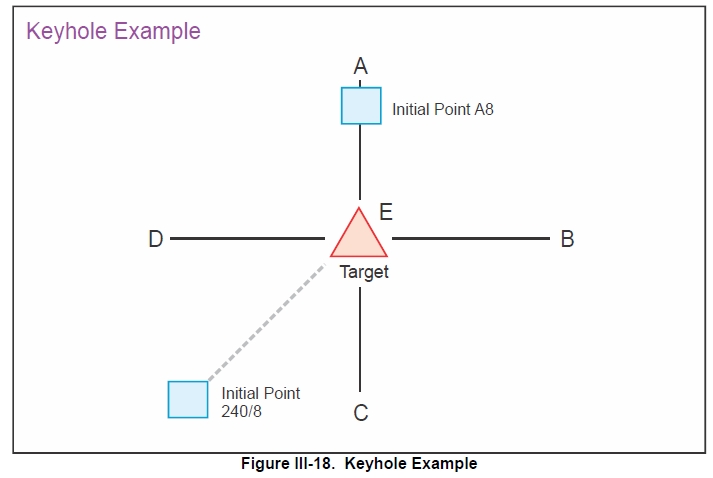Keyhole
Document according to "jp 3-09.3"
The keyhole template is an efficient method for establishing an Initial Point (IP) in Close Air Support (CAS) operations, particularly when traditional control points are unavailable or do not adequately support target engagement.

Keyhole concept:
Purpose: It allows for unlimited flexibility in IP selection and eliminates the need to generate IPs for an entire operational area, many of which might never be used.
Establishment: When CAS aircraft are passed to a Joint Terminal Attack Controller (JTAC) from a Control Point (CP), the JTAC should immediately provide an "Echo" point (typically the target). Aircraft then establish their holding point off of this Echo point using a direction and distance in nautical miles, remaining outside the specified distance.
Labeling: The standard keyhole method labels cardinal directions with letters: A - North B - East C - South D - West E - Overhead Target. Radials can be used when cardinal directions are not suitable.
Selection Criteria: The JTAC selects the IP based on factors such as enemy threat capabilities, target orientation, friendly location, weather, aircraft capabilities, and fire support coordination requirements.
Dynamic Nature: JTACs and Forward Air Controllers (Airborne) (FAC[A]s) must be aware that if target arrays change significantly, the hold point for attacking aircraft will also change when using the keyhole template. This shift must be clearly communicated to avoid deconfliction issues with other airborne assets.
"From the Overhead": If an aircraft is attacking from an orbit directly over the target area, Lines 1-3 of the CAS brief can be stated as "from the overhead" or "Lines 1-3 N/A". However, this does not support all types of attacks, such as Fixed-Wing (FW) level-laydown or ramp/bunt deliveries, which require more extensive airspace.
Limitations: By using the keyhole method, the JTAC/FAC(A) may not have a visually or geographically significant hold point for the attacking aircraft to orient on. Additionally, certain aircraft, like the AV-8B, are not capable of receiving a keyhole template IP, which can be overcome with prior coordination with the supporting squadron.
The keyhole template is a technique for coordinating air attacks, and its discussion was an added modification in the Joint Publication.
📏 Example
If the tactical situation dictates that an IP north of the target is necessary, then holding instructions for the CAS players might sound like this:
JTAC: “Stang 11, advise when ready to copy Echo point.”
CAS Player: “Stang 11, ready to copy.”
JTAC: “Ten-digit grid to follow. NU 87138 50874.”
CAS Player: “I copy NU 87138 50874.”
JTAC: “Stang 11, proceed to Alpha 8, angels 15, report established.”
CAS Player: “Stang 11, established Alpha 8, angels 15.”🥸 Useful Link
Last updated